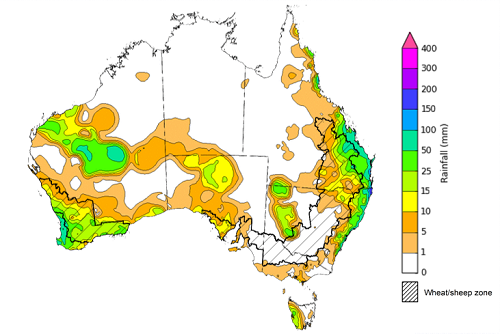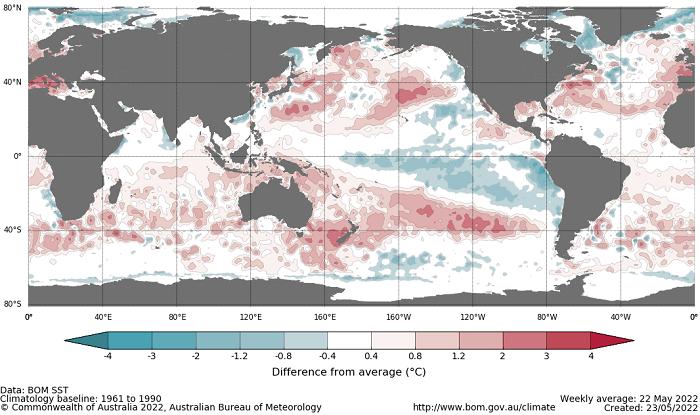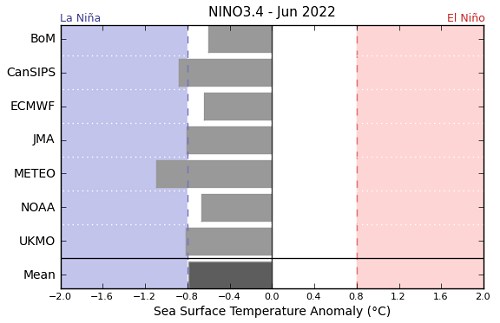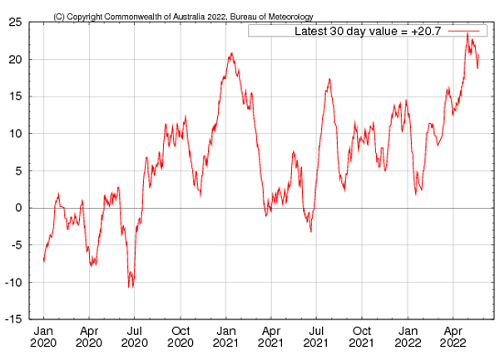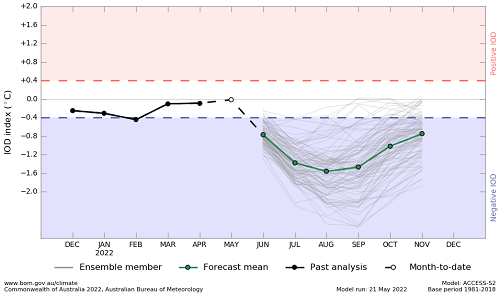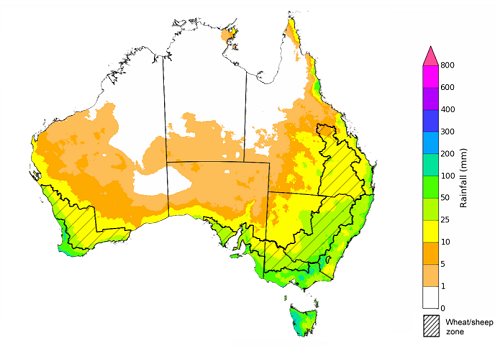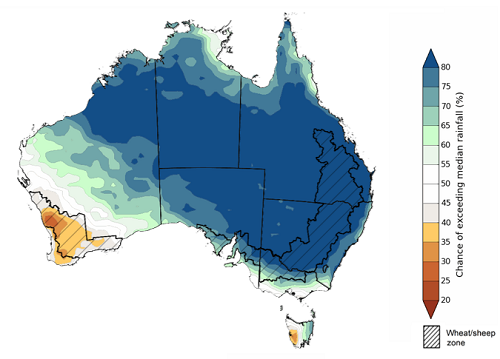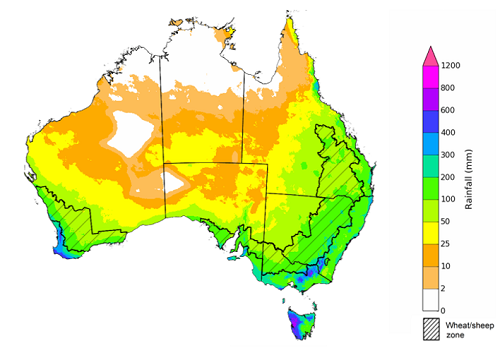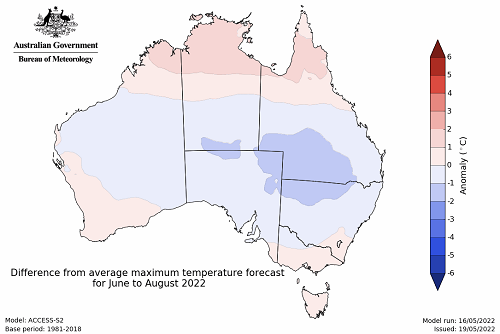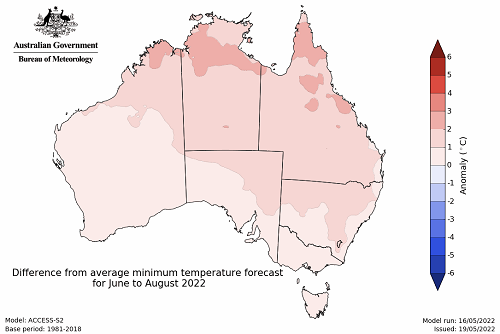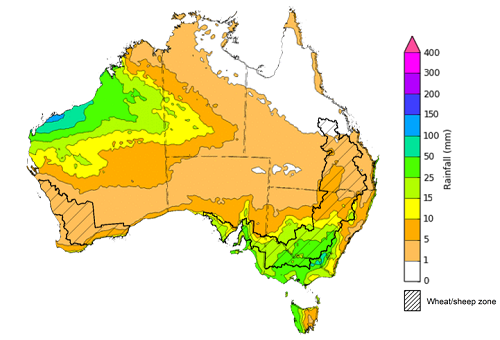Key issues
- For the week ending 25 May 2022, north-west cloudband activity brought rainfall to western and inland parts of the country, while a surface trough off the coast of eastern Australia resulted in rainfall in the east. Cold fronts also brought rainfall to the south-west and western Tasmania. Meanwhile, high-pressure systems to the south of the continent brought dry conditions to remaining parts of southern Australia.
- Following a month of well above average rainfall in northern New South Wales and Queensland, high soil moisture levels are preventing field access for growers to complete harvesting of summer crops (cotton and sorghum) and sowing of winter crops. Little to no rainfall was recorded across these regions over the past week, allowing soil profiles to drain. Across the southern cropping regions of Victoria, South Australia and Western Australia, growers are well-advanced in their winter planting programs.
- A negative IOD event appears increasingly likely to develop through winter, with all climate models indicating the continued formation of a negative IOD in the coming months. A negative IOD is associated with increased rainfall across much of Australia, as well as increased temperatures in northern Australia throughout winter and spring. The 2021–22 La Niña event remains active in the tropical Pacific Ocean, with little change in oceanic and atmospheric indicators over the past few weeks. La Niña events are typically associated with above average rainfall across large parts of eastern Australia during autumn.
- Over the 8-days to 2 June 2022, low-pressure systems are expected to bring moderate to heavy rainfall to the south-east and north-west of the country. High-pressure systems across remaining parts of Australia are forecast to result in mostly dry conditions. Upper soil moisture levels are currently below average across parts of South Australia, so the forecast rainfall will be welcome moisture for growers. If the forecast rainfall for parts of south-east of South Australia is realised it will be the first significant rainfall this season, with many winter crops having been dry sown.
- Water storage in the Murray–Darling Basin (MDB) decreased by 247 gigalitres (GL) between 11 May 2022 and 18 May 2022. The current volume of water held in storage is 21,368GL, which represents 85% of total capacity. This is 45% or 6,633 GL more than at the same time last year.
- Allocation prices in the Victorian Murray below the Barmah Choke remained steady at $27 per ML from 13 May 2022 to 21 May 2022. Prices are lower in the Goulburn-Broken, Murrumbidgee and regions above the Barmah choke due to the binding of the Goulburn intervalley trade limit, Murrumbidgee export limit and Barmah choke trade constraint.
Climate
For the week ending 25 May 2022, north-west cloudband activity brought rainfall to western and inland parts of the country, while a surface trough off the coast of eastern Australia resulted in rainfall in the east. Cold fronts also brought rainfall to the south-west and Tasmania. Meanwhile, high-pressure systems to the south of the continent brought dry conditions to remaining parts of southern Australia.
Rainfall totals of between 10 and 50 millimetres were recorded in eastern and western New South Wales, south-eastern Queensland, central parts of South Australia, the west of Western Australia, as well as western Tasmania. Rainfall totals in excess of 50 millimetres were recorded across north-eastern New South Wales, south-eastern Queensland, as well as isolated parts of the west and south-west of Western Australia. Remaining parts of Australia received little to no rainfall.
In cropping regions, rainfall totals of between 10 and 50 millimetres were recorded in small areas of northern New South Wales, much of eastern Queensland and Western Australia, as well as central areas of South Australia. Rainfall in excess of 50 millimetres was recorded in cropping regions in parts of eastern Queensland. Little to no rainfall was recorded across cropping regions in remaining parts of New South Wales, Queensland, Victoria and South Australia.
Following a month of well above average rainfall in northern New South Wales and Queensland, high soil moisture levels are preventing field access for growers to complete harvesting of summer crops (cotton and sorghum) and sowing of winter crops. Little to no rainfall was recorded across these regions over the past week, allowing soil profiles to drain. However, given the heavy clay soils of these regions, further dry conditions will be required to allow field access to resume. Across the southern cropping regions of Victoria, South Australia and Western Australia, growers are well-advanced in their winter planting programs. Upper layer soil moisture levels are above average for cropping regions of Western Australia, which will provide ideal conditions for the germination and establishment of winter crops. For southern New South Wales, Victoria and the south-east of South Australia, recent dry conditions have allowed sowing of winter crops to progress. However, further rainfall will be required to support crop establishment.
Rainfall for the week ending 25 May 2022
In early winter, the climate drivers with the largest potential impact on Australia’s climate patterns are the Indian Ocean Dipole (IOD), the El Niño–Southern Oscillation (ENSO) and the Southern Annular Mode (SAM). These climate drivers are likely to influence pasture growth across southern Australia and planting opportunities for winter crops.
A negative IOD event appears increasingly likely to develop through winter. The IOD index has dropped below the negative IOD threshold of -0.4 with all climate models indicating the continued formation of a negative IOD in the coming months. A negative IOD is associated with increased rainfall across much of Australia, as well as increased temperatures in northern Australia throughout winter and spring.
The 2021–22 La Niña event remains active in the tropical Pacific Ocean, with little change in oceanic and atmospheric indicators over the past few weeks. La Niña events have the most influence on Australia’s climate through spring and summer, then usually dissipate through autumn. La Niña events are typically associated with above average rainfall across large parts of eastern Australia during autumn, as well as the increased likelihood of tropical cyclones within the Australian region. Even as the event weakens, it is expected to continue influencing climate patterns in Australia over the coming months.
The SAM index is currently neutral and is expected to remain neutral over the coming two weeks. During winter, a positive SAM is associated with decreased rainfall for parts of south-western and south-eastern Australia.
Below average sea surface temperature (SST) anomalies have persisted along the equator in the central and eastern Pacific Ocean. Meanwhile, warm SST anomalies throughout the Maritime Continent have strengthened slightly. Warm sub-surface water temperature anomalies have strengthened slightly in the eastern Pacific Ocean, foreshadowing the breakdown of the current La Niña event.
Difference from average sea surface temperature observations 16 to 22 May 2022
International climate model outlooks for the NINO 3.4 region in June 2022
Four of the seven climate models surveyed by the Bureau of Meteorology expect the La Niña event to continue into June, with two of the models expecting it to remain active throughout winter 2022. For the period ending 22 May 2022, the 30-day SOI was +19.7 and the 90-day SOI was +17.1, both well above the La Niña threshold of +7. Trade winds were stronger than average in the western Pacific but have returned to average strength in the eastern Pacific, and cloudiness near the Date Line remains below average. These indications are consistent with the ongoing La Niña event.
30-day Southern Oscillation Index (SOI) values ending 23 May 2022
As at 22 May 2022, the IOD weekly value was -0.55°C, dipping below the negative threshold (-0.4°C). Four of the five models surveyed by the Bureau of Meteorology expect a negative IOD to form during June, with all five models expecting a negative IOD event by July 2022. A negative Indian Ocean Dipole is not officially declared until there have been at least eight consecutive weeks below the negative threshold. Nevertheless, the formation of a negative IOD will impact Australia’s climate over the coming weeks.
Monthly sea surface temperature anomalies for IOD region
These climate outlooks are generated by ACCESS–S (Australian Community Climate Earth-System Simulator–Seasonal). ACCESS–S is the Bureau of Meteorology's dynamical (physics-based) weather and climate model used for monthly, seasonal and longer-lead climate outlooks.
For further information, go to About the climate outlooks
The Bureau of Meteorology’s latest rainfall outlook indicated wetter than average conditions are expected across the majority of Australia during June. The ACCESS-S climate model suggests there is close to a 60% chance of exceeding median rainfall for most of Australia, while parts of the south-west are likely to receive below average rainfall in June.
The outlook for June 2022 indicates that there is a 75% chance of rainfall totals between 10 and 50 millimetres across most of New South Wales, south-east Queensland, Victoria, southern South Australia, the southwest of Western Australia and Tasmania. Rainfall totals in excess of 100 millimetres are expected in alpine regions of New South Wales and Victoria, as well as western Tasmania.
Across cropping regions there is a 75% chance of rainfall totals of between 10 and 50 millimetres across New South Wales, Victoria, South Australia and Western Australia, as well as most of Queensland. There is a 75% chance of rainfall less than 10 millimetres for parts of northern Queensland cropping regions. The relatively low rainfall forecast for Queensland and northern New South Wales will allow growers to complete summer harvesting and winter sowing, with plentiful soil moisture to support winter crops. In southern cropping regions, winter sowing activity will draw to a close in the coming weeks and the forecast rainfall will assist the establishment of winter crops, especially in Victoria and parts of South Australia.
Rainfall totals that have a 75% chance of occurring June 2022
The rainfall outlook for June to August 2022 suggests there is a greater than 80% chance of exceeding median rainfall across most of New South Wales, Queensland, South Australia, northern Victoria and Western Australia and the Northern Territory. Between June to August 2022, below average rainfall is expected for parts of south-west Western Australia and isolated parts of western Tasmania. For remaining regions of Australia, there is roughly an equal chance of above and below median rainfall (Bureau of Meteorology ‘National Climate Outlook’, 19 May 2022).
Bureau of Meteorology rainfall outlooks for June to August have greater than 55% past accuracy across most of Australia. Outlook accuracy is greater than 65% across large areas of western and eastern Australia.
Chance of exceeding the median rainfall June to August 2022
The outlook for June to August 2022 suggests there is a 75% chance of rainfall totals between 50 and 200 millimetres across much of New South Wales, south-eastern Queensland, Victoria, southern parts of South Australia, the south-west of Western Australia and Tasmania. Rainfall totals in excess of 200 millimetres are forecast for alpine regions of New South Wales and Victoria, the far south-west of Western Australia and western Tasmania.
Across cropping regions, there is a 75% chance of receiving between 50 and 100 millimetres across much of Queensland, north-western Victoria, eastern South Australia and eastern Western Australia. Totals of between 100 and 200 millimetres are expected across much of New South Wales, parts of southern Queensland, southern Victoria, central and western South Australia and western and southern Western Australia.
The rainfall outlook for June to August provides promising conditions for Australian cropping regions, especially for parts of South Australia, which have not received significant rainfall in recent weeks and root zone soil moisture levels are below average to average. The high —75%—chance of close to average winter rainfall across New South Wales, Queensland, Victoria and South Australia will assist crop development in the lead-up to critical stages of flowering and grain fill. The expectation for slightly below average in Western Australian cropping regions presents a slight downside risk to production. Given the above average soil moisture levels for northern New South Wales and southern Queensland, if significant additional rainfall is received over the coming weeks, growers may be unable to plant winter crops in a timely manner. Some growers may opt to wait and plant a larger summer crop instead.
Rainfall totals that have a 75% chance of occurring June to August 2022
The temperature outlook for June to August 2022 indicates that maximum temperatures across most of Australia are likely to be close to the 1990-2012 average (- 1°C to 1°C), with slightly higher than average temperatures across the tropical north, and lower than average temperatures in parts of eastern and central Australia. Minimum temperatures are expected to be slightly above average for much of the northern two thirds of Australia, and close to average for the rest of Australia (Bureau of Meteorology ‘National Climate Outlook’, 19 May 2022).
Predicted maximum temperature anomaly for June to August 2022
Predicted minimum temperature anomaly for June to August 2022
Over the 8-days to 2 June 2022, low-pressure systems are expected to bring moderate to heavy rainfall to the south-east and north-west of the country. High-pressure systems across remaining parts of Australia are forecast to result in mostly dry conditions.
Rainfall totals of between 10 and 50 millimetres are forecast for central and southern New South Wales, much of Victoria, the south of South Australia, as well as northern parts of Western Australia, the south-west of the Northern Territory and western Tasmania. Rainfall in excess of 50 millimetres is expected for alpine areas of New South Wales and Victoria, as well as the north-west of Western Australia.
In Australian cropping regions, rainfall totals of between 10 and 50 millimetres are expected for central and southern New South Wales, much of Victoria and South Australia. Little to no rainfall is forecast for all remaining cropping regions during the next 8-days.
The forecast dry conditions for northern New South Wales and Queensland will allow soils to continue to drain, following a month of well above average rainfall. The dry conditions will also allow unharvested summer crops to dry. And if dry conditions persist, growers will be able to access fields to complete summer harvesting and sowing of winter crops.
Sowing of winter crops are well-advanced across southern cropping regions, and the forecast rainfall for southern New South Wales, Victoria and South Australia will support the germination and establishment of winter crops. Upper soil moisture levels are currently below average across parts of South Australia, so the forecast rainfall will be welcome moisture for growers. If the forecast rainfall for parts of south-east of South Australia is realised it will be the first significant rainfall this season, with many winter crops having been dry sown.
Total forecast rainfall (mm) for the period 26 May to 2 June 2022
Water
Water storages, water markets and water allocations - current week
The Tableau dashboard may not meet accessibility requirements. For information about the contents of these dashboards contact ABARES.
Commodities
Information on weekly price changes in agricultural commodities is now available at the Weekly commodity price update.

